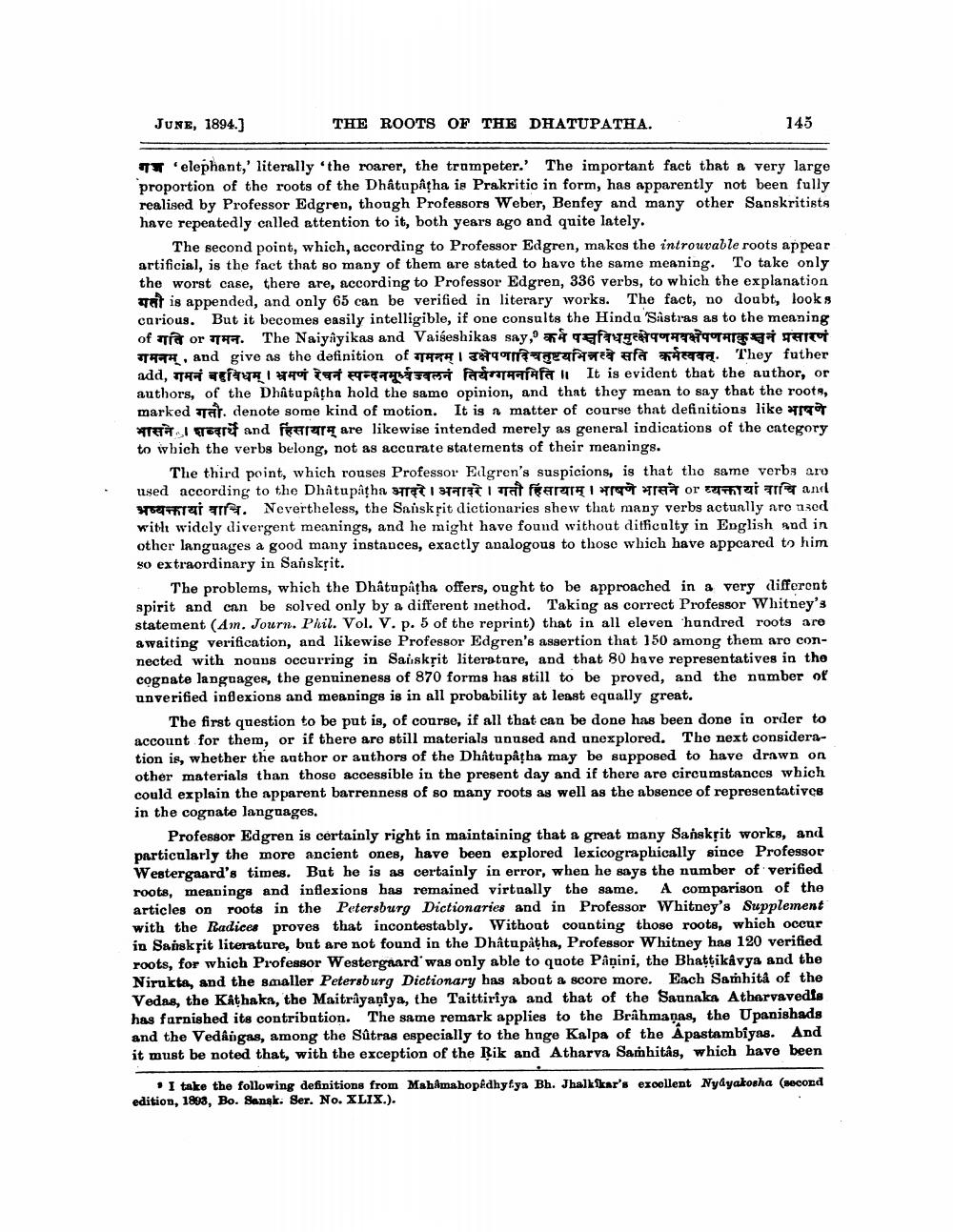________________
JUNE, 1894.]
THE ROOTS OF THE DHATUPATHA.
145
elephant,' literally 'the roarer, the trumpeter.' The important fact that a very large proportion of the roots of the Dhâtupâtha is Prakritic in form, has apparently not been fully realised by Professor Edgren, though Professors Weber, Benfey and many other Sanskritists have repeatedly called attention to it, both years ago and quite lately.
The second point, which, according to Professor Edgren, makes the introuvable roots appear artificial, is the fact that so many of them are stated to have the same meaning. To take only the worst case, there are, according to Professor Edgren, 336 verbs, to which the explanation at is appended, and only 65 can be verified in literary works. The fact, no doubt, looks curious. But it becomes easily intelligible, if one consults the Hindu Sastras as to the meaning of गति or गमन. The Naiyáyikas and Vaiśeshikas say, कर्म पसविधमुत्क्षेपणमवक्षेपणमाकुञ्चनं प्रसारणं गमनम् and give as the definition of गमनम् । उक्षेपणादिचतुष्टयभिन्नत्वे सति कर्मस्ववत्. They futher add, गमनं बहुविधम् । भ्रमणं रेचनं स्पन्दनमूज्वलनं तिर्यग्गमनमिति । It is evident that the author, or authors, of the Dhâtupâtha hold the same opinion, and that they mean to say that the roots, marked . denote some kind of motion. It is a matter of course that definitions like भासने । शब्दार्थे and हिंसायाम् are likewise intended merely as general indications of the category to which the verbs belong, not as accurate statements of their meanings.
The third point, which rouses Professor Edgren's suspicions, is that the same verbs aro used according to the Dhatupatha आदरे । अनावरे । गतौ हिंसायाम् । भाषणे भासने or व्यक्तायां वाचि and a. Nevertheless, the Sanskrit dictionaries shew that many verbs actually are used with widely divergent meanings, and he might have found without difficulty in English and in other languages a good many instances, exactly analogous to those which have appeared to him so extraordinary in Sanskrit.
The problems, which the Dhâtupâțha offers, ought to be approached in a very different spirit and can be solved only by a different method. Taking as correct Professor Whitney's statement (Am. Journ. Phil. Vol. V. p. 5 of the reprint) that in all eleven hundred roots are awaiting verification, and likewise Professor Edgren's assertion that 150 among them are connected with nouns occurring in Sanskrit literature, and that 80 have representatives in the cognate languages, the genuineness of 870 forms has still to be proved, and the number of unverified inflexions and meanings is in all probability at least equally great.
The first question to be put is, of course, if all that can be done has been done in order to account for them, or if there are still materials unused and unexplored. The next consideration is, whether the author or authors of the Dhâtupâțha may be supposed to have drawn on other materials than those accessible in the present day and if there are circumstances which could explain the apparent barrenness of so many roots as well as the absence of representatives in the cognate languages.
Professor Edgren is certainly right in maintaining that a great many Sanskrit works, and particularly the more ancient ones, have been explored lexicographically since Professor Westergaard's times. But he is as certainly in error, when he says the number of verified roots, meanings and inflexions has remained virtually the same. A comparison of the articles on roots in the Petersburg Dictionaries and in Professor Whitney's Supplement with the Radices proves that incontestably. Without counting those roots, which occur in Sanskrit literature, but are not found in the Dhâtupatha, Professor Whitney has 120 verified roots, for which Professor Westergaard' was only able to quote Pânini, the Bhaṭṭikâvya and the Nirukta, and the smaller Petersburg Dictionary has about a score more. Each Samhitâ of the Vedas, the Kathaka, the Maitriyaniya, the Taittiriya and that of the Saunaka Atharvavedis has furnished its contribution. The same remark applies to the Brahmanas, the Upanishads and the Vedâigas, among the Sûtras especially to the huge Kalpa of the Apastambîyas. And it must be noted that, with the exception of the Rik and Atharva Samhitâs, which have been
I take the following definitions from Mahamahopêdhyfya Bh. Jhalkkar's excellent Nyåyakosha (second edition, 1893, Bo. Sansk. Ser. No. XLIX.).




